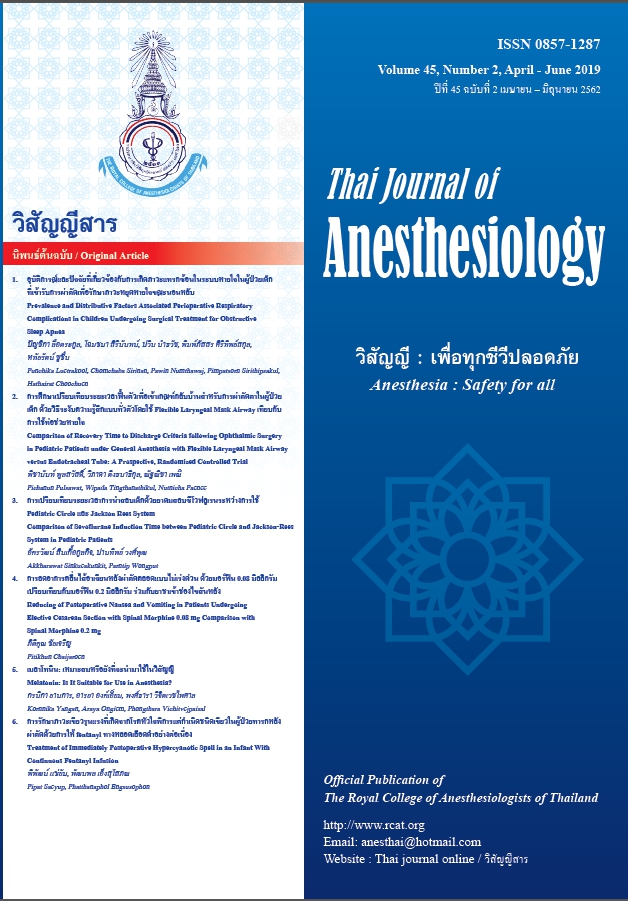Comparison of Recovery Time to Discharge Criteria following Ophthalmic Surgery in Pediatric Patients under General Anesthesia with Flexible Laryngeal Mask Airway versus Endotracheal Tube: A Prospective, Randomized Controlled Trial
Main Article Content
บทคัดย่อ
วัตถุประสงค์ของการศึกษา: การใช้ flexible laryngeal
mask airway (fLMA) ช่วยลดอุบัติการณ์ภาวะแทรกซ้อนจาก
การใส่ท่อช่วยหายใจเพื่อการระงับความรู้สึกในผู้ป่วยเด็ก
การศึกษานี้มีวัตถุประสงค์หลักคือ เปรียบเทียบระยะเวลา
ฟื้นตัวจนเข้าเกณฑ์จำหน่ายผู้ป่วยกลับบ้าน หลังการระงับ
ความรู้สึกแบบทั่วตัว โดยใช้ fLMA เทียบกับการใช้ท่อช่วย
หายใจ สำหรับผ่าตัดตาในผู้ป่วยเด็ก และวัตถุประสงค์รองคือ
เปรียบเทียบการเกิดภาวะแทรกซ้อนจากการระงับความรู้สึก
วธิ กี ารศกึ ษา: การศึกษาเปรยี บเทียบกับกลมุ่ ควบคุม ในผู้ป่วย
เด็กอายุ 1-10 ปี ที่มาผ่าตัดตาและได้รับการระงับความรู้สึก
แบบทั่วตัว ในโรงพยาบาลจุฬาลงกรณ์ โดยสุ่มเป็น 2 กลุ่ม
คือ กลุ่มทดลอง (fLMA) ได้รับการระงับความรู้สึกโดยใช้
fLMA ส่วนกลุ่มควบคุม (ETT) ใช้ท่อช่วยหายใจ ประเมิน
คะแนน Pediatric Post anesthesia Discharge Scoring
System (Ped-PADSS) ทันทีที่ถึงห้องพักฟื้น และประเมิน
ทุก 10 นาที จนเข้าเกณฑ์ลจำหน่ายกลับบ้าน (Ped-PADSS
≤ 9 คะแนน)ผลการศึกษา: ผู้ป่วยเด็กทั้งหมด 40 คน อยู่ในกลุ่มควบคุม
(ETT) 21 คน และกลุ่มทดลอง (fLMA) 19 คน การวิเคราะห์
ข้อมูลทางสถิติ ไม่พบความแตกต่างของระยะเวลาเฉลี่ยการ
ฟื้นตัวจนเข้าเกณฑ์จำหน่ายกลับบ้านในระหว่างสองกลุ่ม
อย่างมีนัยสำคัญ (p-value=0.233) ที่ 10 นาทีหลังผ่าตัด
มีจำนวนผู้ป่วยเด็กในกลุ่ม ETT เข้าเกณฑ์จำหน่ายกลับบ้าน
มากกว่ากลุ่ม fLMA แต่ไม่มีนัยสำคัญทางสถติ (95.24% vs
73.68%; p=0.085) อุบัติการณ์ของภาวะแทรกซ้อนจากการ
ระงับความรู้สึกไม่แตกต่างกันในผู้ป่วยทั้งสองกลุ่ม
สรุป: ไม่พบความแตกต่างที่มีนัยสำคัญทางคลินิกและทาง
สถิติของระยะเวลาฟื้นตัวจนเข้าเกณฑ์จำหน่ายกลับบ้าน
ระหว่างการใช้ fLMA และท่อช่วยหายใจ เพื่อระงับความรู้สึก
สำหรับผ่าตัดตาในผู้ป่วยเด็ก
Article Details
เอกสารอ้างอิง
Flexi laryngeal mask airway vs. endotracheal intubation for
paediatric ophthalmic surgery. IOSR-JDMS 2013; 4(4): 1-6
2. Gulati M, Mohta M, Ahuja S, Gupta VP. Comparison of
layngeal mask airway with tracheal tube for ophthalmic
surgery in paediatric patients. Anaesth Intensive Care 2004;
32: 383-9
3. Martin-Castro C, Montero A. Flexible laryngeal mask as an
alternative to reinforced tracheal tube for upper chest, head
and neck oncoplastic surgery. European Journal of
Anaesthesiology 2008; 25: 261-6
4. Gul R, Goksu S, Ugur BK, et al. Comparison of proseal
laryngeal mask and endotracheal tube for airway safety in
pediatric strabismus surgery. Saudi Med J 2012; 33(4):
388-94
5. Ates Y, Alanoglu Z, Uysalel A. Use of laryngeal mask airway
during ophthalmic surgery results in stable circulation and
few complications: a prospective audit. Acta Anaesthesiol
Scand 1998; 42: 1180-3
6. Biedermann S, Wodey E, De La Briere F, Pouvreau A, Ecoffey
C. Paediatric discharge score in ambulatory surgery. Ann Fr
Anesth Reanim 2014; 33: 330-334
7. Choon L. Bong, Agnes S.B. Nge. Evaluation of emergence
delirium in Asian children using the Pediatric Anesthesia
Emergence Delirium Scale. Ped Anesth 2009; 19: 593–600
8. Klockgether-Radke A, Gerhardt D, Muhlendyck H, Braun U.
Influence of the laryngeal mask airway on the incidence of
postoperative vomiting and of sore throats in children.
Anaesthesist 1996; 45(11): 1085-8
9. Zhao N, Deng F, Yu C. Anesthesia for pediatric day-case
dental surgery: a study comparing the classic laryngeal mask
airway with nasal tracheal intubation. The Journal of
Craniofacial Surgery 2014; 25(3): e245-8
10. Chavalittamrong B, Tarnpradub S, Vanprapar N. Height and
weight of Thai children: high socioeconomic group of the
some selected urban population. J Med Assoc Thai 1989;
72(4): 185-92
11. Practice guidelines for preoperative fasting and the use of
pharmacologic agents to reduce the risk of pulmonary
aspiration to healthy patients undergoing elective procedures.
Anesthesiology 2017; 126: 376-93
12. Benoit Moncel J, Nardi N, Wodey E, Pouvreau A, Ecoffey C.
Evaluation of the pediatric post anesthesia discharge scoring
system in an ambulatory unit. Ped Anesth 2015; 25: 636-641
13. Samira A, David Costifanzca, Allan M. A comparison of
emergence delirium scales following general anesthesia in
children. Ped Anesth 2010; 20(8): 704-711


